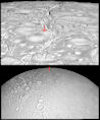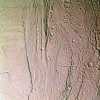Solar System -
Saturn's Moons
Enceladus orbits inside Saturn's outermost E Ring, at a radius of approximately 238,000 km (c. 148,000 miles). It is about 504 km (313 miles) in diameter, and takes 32.9 hours to complete one orbit around Saturn. It rotates synchronously on its axis keeping the same face pointing to Saturn.
Enceladus
A very exciting announcement in 2008 was that water vapor was seen coming from Enceladus' interior, indicating the possibility of liquid water, perhaps as an ocean beneath the frozen surface. The ice appears to be from salt water, which implies a large body of water. Traces of organic compounds have also been found strengthening the theory that the moon could well have a liquid sub-surface ocean. Three of Enceladus geysers are visible in this Cassini image that was taken on May 18, 2010 from a distance of about 14,972 km (9,300 miles).
The schematic of the interior of Enceladus, to the left, is based on information received from the Cassini probe. The brown core is silicate material, while the white layer is the mantle. The yellow and red areas are believed to be a diaprism under the south pole.
A false color close up of some of Enceladus' surface features.
A close up of some of Enceladus' craters and fracture zones.
Another two pictures taken by NASA's Cassini spacecraft in 2011.
The E Ring is a very wide ring comprising ice and/or dust. Known to be at least 300,000 km wide, it may extend well beyond the orbit of Rhea to Titan, making it around 1,000,000 km wide. As the ring would be unstable, new material must be added constantly. Enceladus orbits within the ring at the point where it is at its most dense, so for some time scientists have suggested that it is Enceladus that contributes the material to maintain the E Ring; a hypothesis supported by observations by Cassini.
Saturn's moons are grouped as follows. Select to see details of the moon or the group of moons:
Mimas • Enceladus • Tethys • Dione • Rhea • Titan • Iapetus • Hyperion • Norse Grp • Shepherd Moons • Alkyonides • Inuit Grp • Gallic Grp • Misc
Two views of Enceladus' north pole taken by NASA's Cassini spacecraft in December 2015. .








